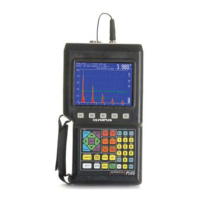Using Software Options
Part # 910-250C
135
Setup parameters include:
• REFLECTOR – This setting must be adjusted when the chosen reference reflector is
either a Side Drilled Hole or a Flat Bottom Hole.The adjustment will be locked out if
other reference reflectors are chosen in the previous menu.
• DELTA-VK – Correction value for angle beam transducers. This value is located on
the DGS/AVG diagram for the selected transducer.
• DELTA VT – Transfer Correction. This value is used to compensate in amplitude
differences as a result of coupling variation (surface condition) from the calibration
block to the test piece. EN 583-2:2001 provides methods for calculating transfer
correction.
• REGISTRATION – This is the height of the main DGS/AVG curve. The curve
represents the amplitude from a flat bottom hole with a diameter of the Registration
Level at different depths. This is usually equal to the critical flaw size for the
application.
• WARNING LEVEL – This is the position of the secondary DGS/AVG “warning”
curve compared to the position of the main DGS/AVG curve. If this value is set to
zero, the “warning” curve will be turned off.
• ACVSPEC – This is the attenuation value in dB/m for the test piece (specimen). In
some cases, it is necessary to calculate the relative attenuation within the test piece
and enter the value here.
• ACVCALBLK - This is the attenuation value in dB/m for the calibration block. In
some cases, it is necessary to calculate the relative attenuation within the calibration
block and enter the value here.
Note: Trained operators must be aware of when it is necessary to apply values to
ACVSPEC and ACVCALBLK. These values affect the shape of the DGS/
AVG curve and will therefore affect the accuracy of defect sizing. A
suggested method for the measurement of relative attenuation can be found
later in this manual.
The operator must use [ENTER] to move from one parameter to the next. The up and
down arrow keys are used for adjusting the individual settings. When settings are
complete, the operator must press the [F1] key to continue.

